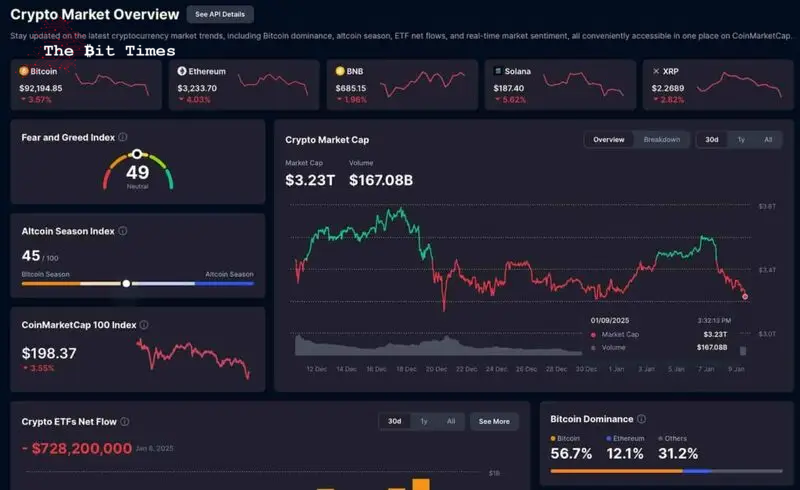Crypto market wipes out $350 billion in two days
The cryptocurrency market has witnessed a precipitous contraction, with $350 billion exiting the market in the last 48 hours.
Data retrieved by Finbold from CoinMarketCap on January 9 reveals that the total market capitalization has plummeted from $3.58 trillion to $3.23 trillion, marking a stark reminder of the asset class’s inherent volatility.
At the epicenter of this decline is Bitcoin (BTC), whose market capitalization eroded from $2.03 trillion to $1.83 trillion within the same period.
Picks for you
Bitcoin’s price, now hovering at $92,203, reflects a dramatic 10% decline over two days, compounded by a 3.12% slide in the past 24 hours alone.
The contagion has spread across the broader digital asset ecosystem, with altcoins suffering parallel declines. Ethereum, the foremost alternative to Bitcoin, has depreciated by 4.03% in the last day as market participants pivot away from higher-beta assets.
Binance Coin (BNB) has retreated by 1.96%, while Solana (SOL), notorious for its susceptibility to volatility, has fallen by a punishing 5.62%. XRP, a pivotal player in the cross-border payments narrative, has also lost 2.82% of its value.

Crypto market sentiment
Investor sentiment, measured by the Crypto Fear and Greed Index, now rests at a precarious 49, reflecting a market caught in a state of ambivalence. The Altcoin Season Index, currently positioned at 45, underscores Bitcoin’s reassertion of dominance as risk-averse capital migrates toward the market’s perceived bellwether asset.
Interestingly, the turbulence has also reverberated across institutional channels. Crypto-focused ETFs have seen a pronounced exodus, with net outflows reaching $728.2 million as of January 8.
What may cause concern for investors is the retreat of institutional capital is often a harbinger of deeper systemic unease, signaling that capital preservation has temporarily supplanted risk appetite.
Bitcoin and macroeconomics
The macroeconomic backdrop has undeniably intensified crypto market fragility. Speculation surrounding central bank monetary policy, particularly the potential for rate adjustments, has sowed apprehension across risk-sensitive markets.
The recent dip in Bitcoin is most likely tied to the possibility of a Federal Reserve interest rate hike, driven by positive U.S. economic data, making digital assets less appealing, with the prospect of tighter monetary policy amplifying market corrections.
Market analysts are now keenly observing pivotal support thresholds, with Bitcoin’s $90,000 level emerging as a crucial psychological marker.
A breach of this level could catalyze a further cascade of liquidation, while a robust defense could invigorate market sentiment and spark a relief rally.
Featured image via Shutterstock
Comments
Post a Comment